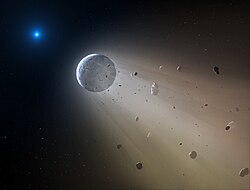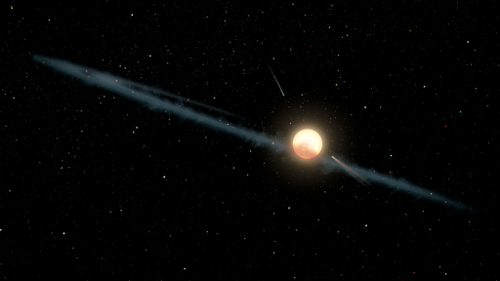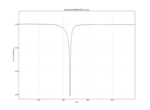Разрушенная планета
Материал из Википедии — свободной энциклопедии

Разрушенная планета (англ. Disrupted planet)[1][2] — планета или экзопланета, разрушенная ближайшей или пролетевшей мимо звездой или другим астрономическим объектом[1][2]. Результатом подобного разрушения может являться возникновение большого количества газа, пыли и других остатков планеты[3], которые могут окружать центральную звезду в виде околозвёздного или остаточного диска. При этом вращающиеся остатки планеты могут представлять собой «нерегулярное кольцо из пыли», создающее неправильные флуктуации видимого блеска центральной звезды и способное приводить к мерцанию кривой блеска; похожими свойствами обладает излучение, наблюдающееся у переменных звёзд KIC 8462852, RZ Рыб и WD 1145+017. У таких звёзд может наблюдаться избыточное количество инфракрасного излучения[4], что также поддерживает гипотезу о наличии пыли и остатков планетного тела рядом со звездой[3][5][6][7].
Примеры
[править | править код]Планеты
[править | править код]Примеры планет (или связанных с ними остатков), считающихся разрушенными объектами или частью таких объектов, включают Оумуамуа[8] и WD 1145+017 b, а также астероиды[9], горячие юпитеры[10] и некоторые гипотетические планеты, такие как пятая планета, Фаэтон и Тейя.
Звёзды
[править | править код]Примеры звёзд, у которых, как предполагается, есть следы разрушенных планет, включают EPIC 204278916, KIC 8462852 (звезда Табби), PDS 110, RZ Рыб, WD 1145+017 и 47 Большой Медведицы.

Кривая блеска KIC 8462852
[править | править код]KIC 8462852 является звездой спектрального класса F главной последовательности, обладающей необычной переменностью излучения, включая ослабление света почти на 22 %[11]. Для объяснения такой переменности было предложено несколько гипотез, но ни одна из них в настоящее время (середина 2019 года) не может объяснить всех деталей кривой блеска. Одним из объяснений является то, что вокруг звезды вращается «неправильное пылевое кольцо»[12][13].

-
Данные со всей кривой блеска −
с декабря 2009 года по май 2013 года,
дни сканирования 0066 − 1587
(только данные Kepler) -
5 марта 2011 года − 792 день,
глубина минимума 15% (данные Kepler) -
28 февраля 2013 года − день 1519,
глубина минимума 22% (данные Kepler) -
17 апреля 2013 года − день 1568,
глубина минимума 8% (данные Kepler)
Примечания
[править | править код]- ↑ 1 2 Staff. Young Star RZ Piscium is ‘Eating’ Its Own Planets, Astronomers Say. Sci-News.com (22 декабря 2017). Дата обращения: 23 декабря 2017. Архивировано 22 декабря 2017 года.
- ↑ 1 2 Fryling, Kevin IU astronomer's analysis helps discover that a star in the constellation Pisces is a 'planet-eater'. Indiana University (21 декабря 2017). Дата обращения: 23 декабря 2017. Архивировано 23 декабря 2017 года.
- ↑ 1 2 Punzi, K. M.; Kastner, J. H.; Melis, C.; Zuckerman, B.; Pilachowski, C.; Gingerich, L.; Knapp, T. Is the Young Star RZ Piscium Consuming Its Own (Planetary) Offspring? (англ.) // The Astronomical Journal : journal. — IOP Publishing, 2017. — 21 December (vol. 155). — P. 33. — doi:10.3847/1538-3881/aa9524. — . — arXiv:1712.08962.
- ↑ Farihi, J.; Jura, M.; Zuckerman, B. Infrared Signatures of Disrupted Minor Planets at White Dwarfs (англ.) // The Astrophysical Journal : journal. — IOP Publishing, 2009. — 10 March (vol. 694, no. 2). — P. 805—819. — doi:10.1088/0004-637X/694/2/805. — . — arXiv:0901.0973.
- ↑ Landau, Elizabeth Mysterious Dimming of Tabby's Star May Be Caused by Dust. NASA (4 октября 2017). Дата обращения: 23 декабря 2017. Архивировано 28 ноября 2020 года.
- ↑ Meng, Huan Y.A. Extinction and the Dimming of KIC 8462852 (англ.) // The Astrophysical Journal : journal. — IOP Publishing, 2017. — 3 October (vol. 847). — P. 131. — doi:10.3847/1538-4357/aa899c. — . — arXiv:1708.07556. Архивировано 28 августа 2020 года.
- ↑ Tabor, Abby The scientific quest to explain Kepler's most enigmatic find. Phys.org (5 октября 2017). Дата обращения: 23 декабря 2017. Архивировано 2 декабря 2020 года.
- ↑ Ćuk, Matija. 1I/ʻOumuamua as a Tidal Disruption Fragment From a Binary Star System (англ.) // The Astrophysical Journal : journal. — IOP Publishing, 2017. — Vol. 852. — P. L15. — doi:10.3847/2041-8213/aaa3db. — . — arXiv:1712.01823.
- ↑ Soter, Steven. What is a Planet? (англ.) // The Astronomical Journal : journal. — IOP Publishing, 2006. — Vol. 132, no. 6. — P. 2513. — doi:10.1086/508861. — . — arXiv:astro-ph/0608359.
- ↑ Nayakshin, Sergei. Hot Super Earths: disrupted young jupiters? (англ.) // Monthly Notices of the Royal Astronomical Society : journal. — Oxford University Press, 2011. — 20 September (vol. 416, no. 4). — P. 2974—2980. — doi:10.1111/j.1365-2966.2011.19246.x. — . — arXiv:1103.1846. Архивировано 27 апреля 2021 года.
- ↑ Boyajian, T. S.; LaCourse, D. M.; Rappaport, S. A.; Fabrycky, D.; Fischer, D. A.; Gandolfi, D.; Kennedy, G. M.; Korhonen, H.; Liu, M. C. Planet Hunters IX. KIC 8462852 – where's the flux? (англ.) // Monthly Notices of the Royal Astronomical Society : journal. — Oxford University Press, 2016. — 27 January (vol. 457, no. 4). — P. 3988—4004. — ISSN 0035-8711. — doi:10.1093/mnras/stw218. — arXiv:1509.03622. Архивировано 14 ноября 2018 года.
- ↑ Mysterious Dimming of Tabby's Star May Be Caused by Dust. NASA/JPL. Дата обращения: 13 ноября 2018. Архивировано 28 ноября 2020 года.
- ↑ Boyajian, Tabetha S.; Alonso, Roi; Ammerman, Alex; Armstrong, David; Ramos, A. Asensio; Barkaoui, K.; Beatty, Thomas G.; Benkhaldoun, Z.; Benni, Paul. The First Post-Kepler Brightness Dips of KIC 8462852 (англ.) // The Astrophysical Journal : journal. — IOP Publishing, 2018. — 19 January (vol. 853, no. 1). — P. L8. — ISSN 2041-8213. — doi:10.3847/2041-8213/aaa405. — arXiv:1801.00732. Архивировано 23 июля 2019 года.
- ↑ Gary, Bruce L. Hereford Arizona Observatory photometry observations of KIC 8462852. BruceGary.net (14 ноября 2017). Дата обращения: 24 декабря 2017. Архивировано 2 января 2018 года.
- ↑ Gary, Bruce L. Hereford Arizona Observatory photometry observations of KIC 8462852 between 2 May and 4 October 2017. BruceGary.net (4 октября 2017). Дата обращения: 23 декабря 2017. Архивировано из оригинала 4 октября 2017 года.
"Note: g'-band and r'-band dip depths (and shapes) may differ, with g'-band being more sensitive to dust cloud scattering due to its shorter wavelength (0.47 vs. 0.62 micron). For a reasonable particle size distribution (e.g., Hanson, 0.2 micron) the extinction cross section ratio would produce a depth at r'-band that is 0.57 x depth at g'-band. If g'-band depth is 0.3 %, for example, depth at r'-band could be 0.17 %. The "Tabby Team" measurements (Fig. 3) at r'-band are compatible with that small dip depth. Incidentally, none of these shapes resemble exo-comet tail transits (as described by Rappaport et al, 2017 link); so the mystery of what's producing these week-timescale dips continues! Actually, long oval shapes are known to produce V-shaped dips (think of rings with a high inclination)." - bg - ↑ Gary, Bruce L. Hereford Arizona Observatory photometry observations of KIC 8462852 between 2 May and 31 December 2017. BruceGary.net (1 января 2018). Дата обращения: 1 января 2018. Архивировано из оригинала 1 января 2018 года.
- ↑ Gary, Bruce L. Hereford Arizona Observatory photometry observations of KIC 8462852 between 2 May 2017 and 4 May 2018. BruceGary.net (4 мая 2018). Дата обращения: 5 мая 2018. Архивировано из оригинала 5 мая 2018 года.
Литература
[править | править код]- Wallace Gary Ernst. The Dynamic Planet. — Columbia University Press, 1990. — ISBN 978-0-231-07231-1.
- Michael M. Woolfson[англ.]. The Origin and Evolution of the Solar System (англ.). — CRC Press, 2000. — ISBN 978-1-4200-3335-9.
- Danny Faulkner. The Expanse of Heaven: Where Creation & Astronomy Intersect (англ.). — New Leaf Publishing Group, Incorporated, 2017. — ISBN 978-1-61458-633-3.
Ссылки
[править | править код]- NASA — WD 1145+017 b на сайте The Extrasolar Planets Encyclopaedia.
- Video (13:46) − "Tabby's Star" на YouTube, презентация от Табеты Бояджян.
- Video (31:00) − "Tabby's Star" на YouTube, презентация от Исаака Артура.
- Video (01:00) − RZ Рыб на YouTube, звезда с необычной переменностью блеска (21 декабря 2017 года).
Text is available under the CC BY-SA 4.0 license; additional terms may apply.
Images, videos and audio are available under their respective licenses.




![Кривая блеска за 1 год − до 4 мая 2018 года (данные обсерватории Хирфорд[14][15][16][17])](https://upload.wikimedia.org/wikipedia/commons/thumb/5/5d/KIC_8462852_Daily_Normalized_Flux_by_Bruce_Gary%2C_20170502-20180504.png/150px-KIC_8462852_Daily_Normalized_Flux_by_Bruce_Gary%2C_20170502-20180504.png)
